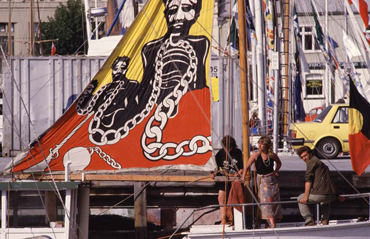
This content is available on the National Archives of Australia website:
Description
This is a colour photograph taken during the 1988 Australian Bicentenary celebrations and shows a boat with three people on board moored at a wharf. The boat's sail depicts three Indigenous Australians linked together with neck chains. A ball and chain and a rifle are shown on the sail and the background colours are the yellow, red and black of the Australian Aboriginal Flag. The Flag can be seen flying on the right of the photograph.
Educational value
- The photograph appears to depict Indigenous protest at the start of the International Tall Ships Race from Hobart to Sydney, part of the Bicentennial celebrations in 1988. The protests offered Aboriginal people a chance to embarrass the government and heighten international awareness of Indigenous issues, as national and international attention was focused on the Bicentenary events. Tall ships from 30 countries took part in the race. The National Aboriginal Week theme for that year was 'We have survived'.
- The image on the sail of this boat illustrates an aspect of the negative effect of European settlement on Indigenous Australians, and shows that not everyone viewed the arrival of the British settlers in Australia as a cause for celebration. The commemoration of Australia's Bicentenary in 1988 raised the question of whether the public should celebrate 200 years of white presence in Australia. The Indigenous protest slogan for the Bicentennial year was 'White Australia has a Black History'.
- Protests such as the one shown in the photograph questioned the celebration of Australia Day and demanded that Australians reflect on the dispossession of Aboriginal peoples, and on ways of redressing the injustice. Protests included a peaceful march of 100,000 Indigenous and non-Indigenous people in Sydney, the largest Indigenous protest in the history of colonised Australia. To many Indigenous people the day was more rightly named 'Invasion Day' or 'Survival Day'.
- The sail depicts a particular hardship suffered by Indigenous people as a result of the arrival of British settlers. Indigenous men were routinely confined in neck chains such as those shown. During the colonial period neck chains were used to restrain and punish convicts, police suspects and Indigenous people. Neck chains were still being used on Indigenous people more than a century after their general use had ceased.
- The Aboriginal Flag of Australia shown on the yacht was designed by Harold Thomas, an Indigenous Elder and Luritja man, in 1971, but was not officially recognised by the Australian Government until 1995. It was first displayed in Adelaide on National Aborigines Day, 12 July 1971. It became the official flag for the Aboriginal Tent Embassy in Canberra from 1972. In July 1995 the Commonwealth proclaimed the Flag a 'Flag of Australia' under the Flags Act 1953. The yellow in the Flag represents the sun (giver of life) and yellow ochre. Red represents the red earth (the relationship to the land) and the red ochre used in ceremonies. Black represents the Indigenous people.
